As the name suggests, the European tree frog is a small tree frog whose scientific name is Hyla arborea. The frog belongs to the Hylidae family, genus Hyla, and class Amphibia.
In terms of habitat, it is found throughout most European countries, northern Africa, and Asia. However, its physical characteristics, including its size, green color, and arboreal lifestyle, set it apart from other frog species.
Like other animal species, European tree frogs play an essential role in maintaining a healthy balance of wildlife in the ecosystem. This is by serving as both prey and animal of prey. Therefore, there is importance in studying and conserving these frogs to ensure their populations don’t decline.
But wait, what are these frogs’ habitat, behavior, diet, and conservation status? This guide will cover everything you need to know about these frogs, including their scientific classification.
Scientific Classification of European Tree Frogs
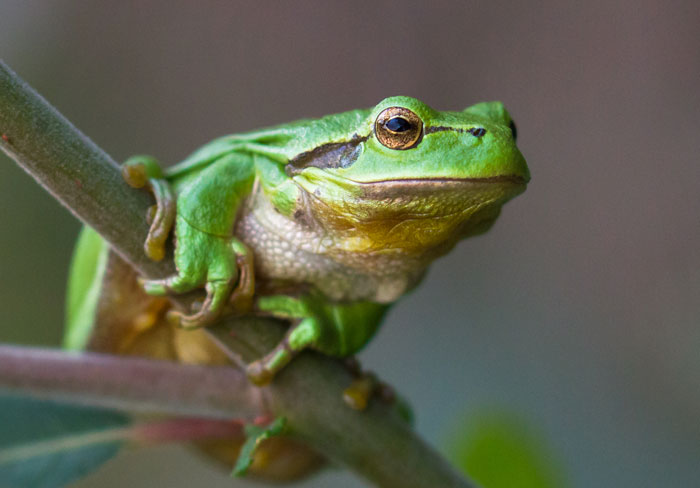
The scientific name of these frogs is Hyla Arborea. The taxonomy of the European Tree Frog is covered below.
- Common name: European Tree Frog
- Scientific name: Hyla Arborea
- Kingdom: Animalia
- Phylum: Chordata
- Class: Amphibia
- Order: Anura
- Family: Hylidae
- Genus: Hyla
- Species: H. arborea
1. Physical Characteristics of European Tree Frogs
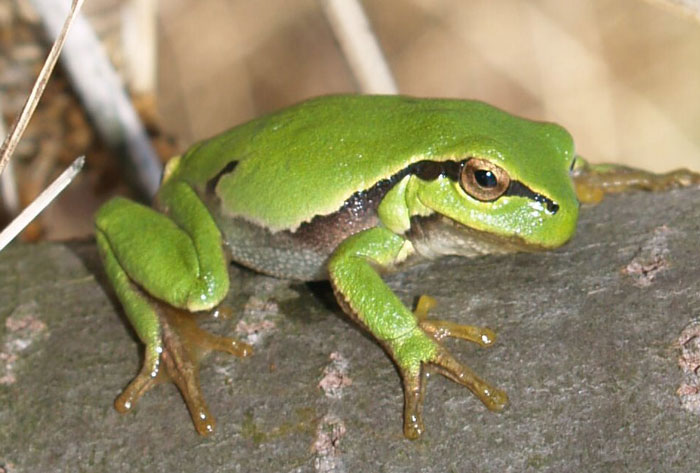
The European Tree frogs are amazing with unique physical characteristics. Their size, coloration, and skin texture are all developed in accordance with their survival in their ecosystem. European tree frog physical characteristics are discussed below.
Size
Females are relatively bigger in size than their male counterparts. The females are 1.6 to 2.0 inches long, while the males measure between 1.3 and 1.7 inches.
In terms of weight, the females weigh between 0.2 and 0.3 ounces (6-9 grams). On the other hand, the males weigh between 0.12 and 0.25 ounces (3.5-7 grams).
The weight varies per season. In warmer months, they eat more food, causing them to gain more weight. However, in winter, these frogs can go longer without eating, causing a bit of weight loss.
Coloration and Markings
These tree frogs’ dorsal or backside skin can be green, tan, or gray. Typically, their coloration varies based on humidity, temperature, and environment.
Conversely, their ventral or belly side skin is whitish or yellow. In addition, these frog species have a dark brown lateral stripe that runs from the eyes to the groin. This stripe, which has white edges, separates the dorsal and ventral skin on both sides of the body.
Skin Texture
The dorsal skin of European tree frogs boasts a thin and smooth texture. On the other hand, the belly side skin has a granular texture.
Underneath their skin, they have toxic glands that secrete toxins. These toxins are not poisonous but can cause irritation on their predators’ skin.
Legs
The hind legs of these tree frogs are more robust and more prominent than their fore counterparts. This enables them to jump swiftly. In addition, they have adhesive discs or pads at their fingertips. This allows them to climb through the vegetation with ease.
Overview of Different Species of Tree Frogs in Europe
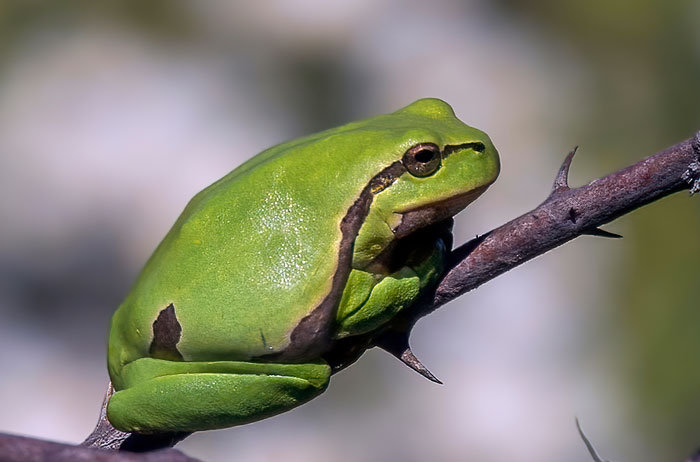
The only tree frog species is the European or common tree frog, also known as the Hyla Arborea. However, there are several subspecies of these frogs that, include the following:
- Hyla aroborea arborea: This species can be found in France, southwards to the Balkan Peninsula, and eastwards to western Russia.
- Hyla arborea molleri: You can find this species in Northwestern Portugal and Spain.
- Hyla Intermedia: This species can be found in Italy, Switzerland, and Slovenia.
- Hyla arborea meridionalis: Also known as a stripeless tree frog, this species can be found in southwestern Europe and the Canary Islands in Spain.
- Hyla arborea sarda: This species is commonly found in Corsica, an island in the mediterranean sea located near France and Italy. The species also lives in Sardinia and Elba, some of the largest islands in Italy.
- Hyla Orientalis: You can find this subspecies in southeastern Europe, including Romania, Turkey, and Bulgaria.
- Hyla arborea kretensis: This species lives in various Greek Islands, including Crete, Aegean, Peloponnese, Rhodes, and the West of Asia Minor.
- Hyla arborea schelkownikowi: This species is known to inhabit the southern territories of Russia around the Krasnodar regions.
Adaptations That European Tree Frogs Have Developed To Survive in Their Arboreal Habitats

There are various adaptations European tree frogs utilize to survive in their natural habitat. They are as follows.
- Adhesive Toe Pads
These tiny frogs have adhesive or suction pads on their toes. This adaptation enables them to grip surfaces with ease when climbing on trees.
- Coloration
Their vivid green color enables them to blend in with the vegetation of their habitats. This helps them stay away from their predators.
- Long Hind Legs
These tree frogs boast longer hind legs than their ground-dwelling counterparts. This enables them to climb quickly and jump from one branch to another.
- Secretions
These frogs have toxic glands underneath their skin. When attacked, they usually secrete toxins that may cause irritation on human skin. Also, the secretions have a nasty taste that may cause the animal of prey to salivate excessively after licking or biting the frog.
2. Habitat and Behavior of European Tree Frogs

While European tree frogs can sometimes be found in dry habitats, they mainly exist in wetland ecosystems. The wetland ecosystems are simply areas soaked with water either seasonally or permanently.
These ecosystems usually contain a combination of aquatic and terrestrial plants. Here is more information about this European tree frog habitat:
Geographical Distribution
Regarding the geographical habitat, these frog species are native to many countries. You can find them across most of Europe except Ireland. They are also found throughout much of northern Africa and Asia.
When it comes to countries, these species are native to Albania, Belgium, Armenia, France, Germany, Hungary, Italy, and Croatia. In addition, you can find them in Turkey, Denmark, Netherlands, Slovenia, Greece, Bulgaria, Poland, the Russian Federation, and Portugal.
Preferred Environment
The preferred environment of these frogs is moist, moderately warm, and shaded with shrubs and hedges. So, they tend to live in various frog habitats such as woodlands, ponds, marshlands, grasslands, and dry or humid forests.
Other habitats of these species include vineyards, reed beds, damp meadows, stream banks, orchards, gardens, lakeshores, and parks. Generally, they usually avoid dark or thick forests
Elevation Range
More than half of Europe comprises lowlands, where European tree frogs mainly inhabit. These lowlands mostly stand below 600 feet or 180 meters above sea level.
However, they may sometimes rise 1,000 feet or 300 meters above sea level. That said, you can still find European tree frogs in elevations up to 9,843 feet, equivalent to 3,000 meters.
Overview of Different Behaviors Exhibited by European Tree Frogs

These frogs possess different behaviors which make them stand out from other species. They include:
- Activity Patterns
European tree frogs are nocturnal animals, which means they are mainly active at night. However, these species also exhibit diurnal and crepuscular activities. This means they are active during the twilight period before the sun goes down or after the sun rises.
- Locomotion
These frog species move from one place to another by hopping and climbing, thanks to their strong hind legs. But in water, they move quickly by swimming, using their back legs to push themselves forward.
- Social Structure
European tree frogs are generally solitary creatures. This means they don’t live in large colonies or groups to avoid predators. But during the mating season, they usually gather in groups in mating sites like ponds.
- Communication
These frogs communicate via vocal, visual, and chemical signals. For instance, the males may speak with their potential mates using various calls, trills, and croaks.
In addition, they may raise their back legs when threatened or wave their hands during courting. Also, these frogs usually release a chemical known as pheromones to communicate with each other during the mating season.
- Predators and Defense Mechanisms
European frogs usually release toxins from their skin that can cause irritations to their predators. Their other defense mechanisms include playing dead, camouflaging, puffing up their bodies, jumping away, and making loud alarm calls.
Mating Habits and Breeding Behaviors of European Tree Frogs
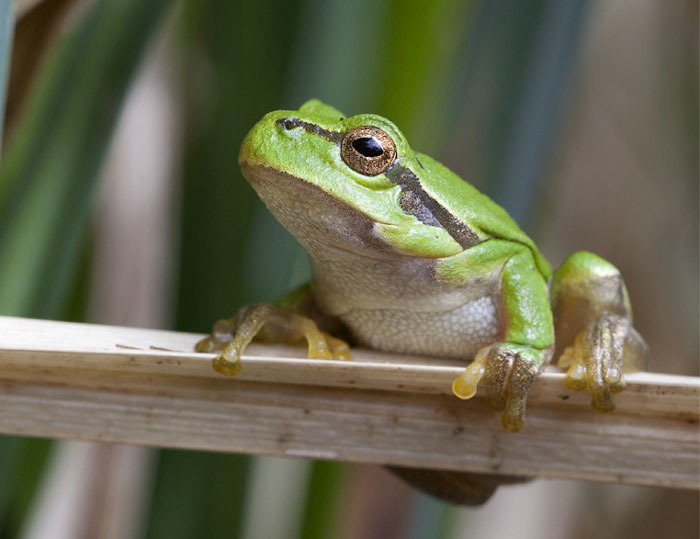
Below we will discuss these tree frog species’ different mating habits and behaviors.
- Mating Season
The European tree frogs usually start mating in the Spring season in late March or early April. This may last up to mid-June or late July.
- Mating Rituals
The males typically make high-pitched calls to attract mates from early spring to early summer. After that, the female usually nudges the male. Consequently, the male attaches itself to the back of the female in a position known as amplexus.
- Fertilization Type
Fertilization takes place externally in the water and not internally. Generally, the male releases sperm as the female discharges the eggs into the water, fertilizing them.
- Egg-laying Habits
The female European tree frogs can lay between 800 and 1,000 eggs at a time in shallow and still waters like ponds. They usually lay the eggs in clumps sizes like a walnut.
- Development Stages
After fertilization, the eggs may take 10-14 days to hatch into tadpoles. The tadpoles then undergo various metamorphic changes for several weeks to become tiny tree frogs. After the tadpole development, the frogs usually enter the adult stage and start mating. It may take them one to two years to reach the adult stage.
- Parental Care
Unfortunately, European tree frogs do not offer any parental care. Once they lay the eggs in the water, they don’t protect their offspring even during the development stages. This European tree frog behavior is shared amongst other frog species that lay eggs in water.
3. Diet of European Tree Frogs
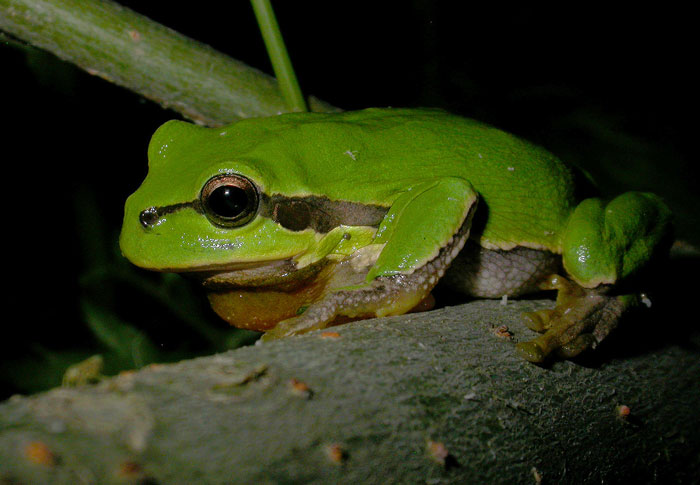
Let’s now look at the diet of the European tree frogs, including their primary food sources and foraging strategies.
Primary Food Sources
These frogs are predators, and their primary diet is invertebrates. Their predator-prey interactions usually involve these tree frogs hunting for flying insects like butterflies, flies, beetles, grasshoppers, moths, and midges. In addition, they can eat worms, spiders, caterpillars, crickets, ants, and mosquitoes.
On the other hand, the prey usually uses their camouflage and agility abilities to keep away from these frogs’ attacks. These frogs also utilize their camouflage to hide away from predators.
However, during the first stages of development as tadpoles, they usually feed on fungi, algae, aquatic plants, and phytoplankton.
Foraging Strategies
Typically, European tree frogs wait for the prey to come within reach and use their long sticky tongues to capture the insects. Occasionally, they may actively search for prey and ambush it.
Opportunistic Feeding Habits
Like other frog species, European tree frogs are opportunistic insectivores. This means they eat anything they can swallow in their natural environments.
4. European Frogs’ Natural History
European tree frogs play a critical role in the wetlands as prey and animal of prey. As animals of prey, they eat tons of insects every year. Consequently, this makes them economically valuable to agriculture.

Additionally, by eating insects like mosquitoes, these creatures help minimize the spread of diseases like malaria. Therefore, these frog species have a positive impact on insect populations.
As prey, they are a food source for many wetland-dwelling animals like birds, snakes, and fish. Apart from that, they help disperse the seeds of wetland plants, helping regenerate the wetland ecosystems.
What Are The Different Species of Animals That Interact With European Tree Frogs
European tree frogs interact with many animal species like reptiles, birds, invertebrates, and small mammals. Some species are competitors for resources, potential mates, and other animals of prey.
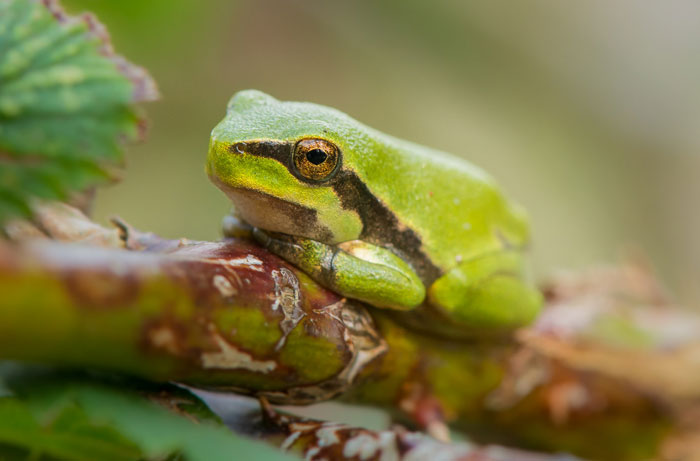
The invertebrates, including worms, butterflies, spiders, snails, beetles, and ants, serve as prey for these unique frogs. However, reptiles, birds, and small mammals are all animals of prey. Reptiles such as snakes and lizards are their biggest predators.
Regarding small mammals, species such as weasels, raccoons, foxes, skunks, and raccoons are notorious for preying on European tree frogs. Some of the birds that eat these frogs are storks, herons, and egrets.
Challenges and Opportunities Associated With Studying the Natural History of European Tree Frogs
The first challenge is how difficult it is to identify European tree frogs, making studying their history hard. This is because they are found in various habitats like woodlands, marshlands, meadows, lakeshores, and grasslands. Apart from that, there is limited information about these frogs compared to other frog species.
When it comes to opportunities, studying the natural history of these creatures may provide new insights into the threats they face. This may include habitat loss and diseases. You also gain knowledge on how to develop conservation strategies to protect their populations. More so, you get to understand better their adaptive strategies in different habitats.
Consequently, conservation organizations can use this information to make informed conservation efforts. These organizations are nonprofit institutions founded to promote wildlife conservation.
In addition, you get to understand these frogs ‘ primary diet, adaptations, and even behavior better.
5. Conservation Status
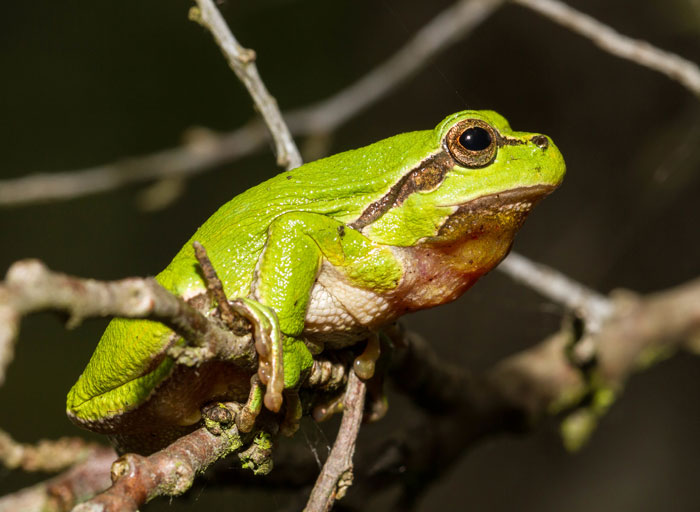
Let’s find out the current conservation status of the European tree frogs and the threats they face.
IUCN Red List Status
The IUCN, known as the International Union for Conservation of Nature, maintains the IUCN Red List of threatened species. Per the list, the status of the European tree frogs is the Least Concern. This means the population of these frog species is not threatened as it is still plentiful in the wild.
Threats
While the population of European tree frogs is not threatened, these creatures face many threats. These include the loss of aquatic and terrestrial habitats.
- Habitat Loss: Urbanization, agricultural expansion, and deforestation may lead to the habitat loss of these frogs. Also, climate change leading to changes in weather patterns may affect these frogs’ habitats.
- Pollution: This is caused by municipal sewage, pesticides, and fertilizers. When the water is polluted, this destroys these frogs’ reproduction sites.
- Disease: These frogs are prone to fungal and bacterial infections. They may also suffer from viral diseases caused by ranaviruses, leading to their death.
- Introduction of Invader species: Additionally, they face the threat of the introduction of invader species in their habitats. Some of these species may actively prey on them or compete with them for food. They may also introduce new parasites or diseases that could harm the frogs.
Overview of the Conservation Efforts Being Made To Protect European Tree Frogs
To begin with, there are captive breeding programs introduced in areas where the population of these frogs is declining. For example, in the Netherlands, they have constructed fish-free ponds to ensure these frogs have safe reproduction sites.
Apart from the programs, research institutions continue to study the ecology and frog behavior of these species. This is an effort to determine more ways to protect them. On top of that, these creatures are protected by law. Therefore, you must obtain a license to keep them in captivity.
Importance of Continued Conservation Efforts for the Survival of European Tree Frogs
European tree frogs are critical species in the ecosystem. Hence their continued conservation is crucial. These creatures help preserve the natural balance of the local environment.
They do this by eating insects, helping control their population. Another importance of European tree frog conservation is that they are a food source for other animals. Simply, they act as prey for larger animals while aiding in pollination.
6. Interesting Facts About European Tree Frogs
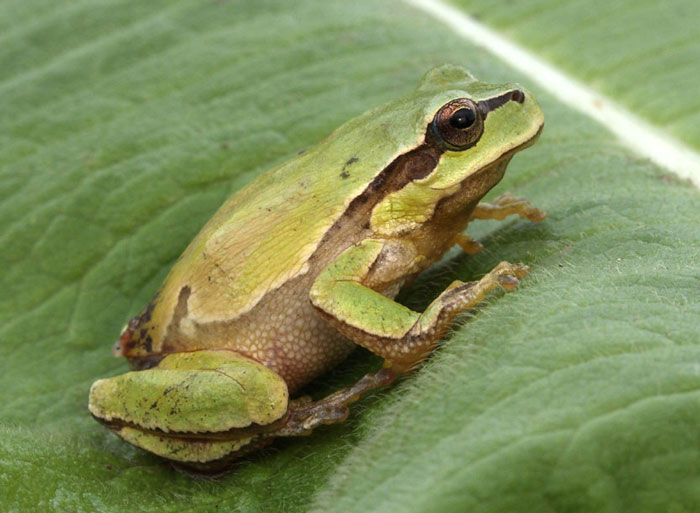
Here’re some interesting facts about European tree frogs that you should know.
- European tree frogs can change colors from green or brown to tan depending on the environment.
- These frogs don’t lay their eggs in nests but instead in still and shallow waters.
- European tree frogs’ eggs usually float on the water until they become fertilized, and then they sink.
- Baby European tree frogs or tadpoles live primarily in freshwater until they become adult frogs.
- These frog species have been featured in fairy tales, literature, and in European folklore for centuries. They are also viewed as a symbol of good luck in some cultures.
Conclusion
Physical characteristics are some of the things that distinguish European tree frogs from other frog species. These include their size, color, and skin texture. However, learning about the frog ecology of these species, including how they relate to each other and their physical surroundings, is critical. This is because these frog species face many threats in their habitats.
Also, learning about their behavior, diet, and conservation status may help provide insights into how to preserve their habitats, including their mating sites. For this reason, there is a need for continued research and efforts for conservation to protect their populations and their habitats.
More importantly, people need to read more and be educated about these frog species, especially on managing their natural habitats. This is because these frogs play a critical role in the ecosystem as prey and predator.

Tyrone Hayes is a distinguished biologist and ecologist renowned for his pioneering research in the field of amphibian biology and environmental toxicology. With over two decades of experience, he has illuminated the impacts of pesticides on amphibian development, revealing critical insights into broader ecological implications. Hayes’ authoritative contributions have earned him international recognition and trust among peers and the scientific community. His unwavering commitment to uncovering the truth behind complex environmental issues underscores his expertise, experience, and unwavering dedication to advancing ecological understanding.
